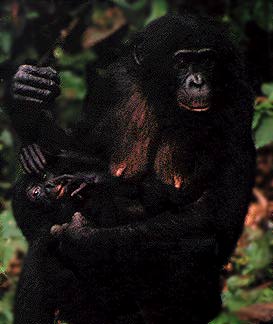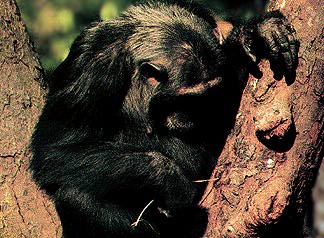
 |
Pongids |
 Orangutans
are found in the Southeastern countries of Sumatra and Borneo. They live
in tropical rain forests, and are found at all levels of the forest on
small branches. Rarely do they come down to the forest floor. Older individuals,
however, may be forced to live most of their life on the ground due to
their loss of strength and weight gain.
Orangutans
are found in the Southeastern countries of Sumatra and Borneo. They live
in tropical rain forests, and are found at all levels of the forest on
small branches. Rarely do they come down to the forest floor. Older individuals,
however, may be forced to live most of their life on the ground due to
their loss of strength and weight gain.
Dental formula for orangutans is 2:1:2:3. They are predominantly frugivores, but have also been observed eating leaves, bark and bird eggs.
Orangutans are cautious climbers, and are mainly arboreal. In the trees they move by grasping slender branches and climbing. They are usually cautious in grabbing branches with two or three arms or legs. On the ground they walk quadrupedally, using the lateral side of the palms. Orangutans are extremely flexible in the hip, knee, and shoulder joint. Their forearms are much longer than their hindlegs. They are diurnal.
Adult orangutans live alone (solitary).
One male may have a territory that covers the range of several females.
Females are found by themselves, unless they have a young child. During
his constant movement within his territory, the male will know when a female
is sexually receptive by the type of calls she makes. Occasionally a young
male will approach a female and attempt to mate with her. Often the female
then calls out for the older male to come to her rescue. A fight between
the males may then occur. The agressive behavior of the younger male and
the attempts by the female to avoid him have been called rape. Why do you
think the female objects to the younger male's advances?
 Chimpanzees
are found in central and southern portions of Africa. They live in tropical
rain forests, deciduous woodlands, and savannah forests.
Chimpanzees
are found in central and southern portions of Africa. They live in tropical
rain forests, deciduous woodlands, and savannah forests.
Chimpanzee dentition is 2:1:2:3. They eat a wide variety of food including fruits, leaves, palm-nuts, seeds, termites, ants, and meat.
Chimps spend 25-30% of the daylight hours walking on the ground. They walk quadrupedally, in a fashion known as knucklewalking. In the trees they climb branch to branch. Occasionally they will walk bipedally. They tend to do this when carrying objects in their hands, displaying, or attempting to see over the horizon.
An individual chimpanzee belongs to a large main group. However, that group will split up at different times during the day. The size of the social group in which a chimp interacts is always changing. Sometimes a chimp will be in a mixed sex group, a one sex group, alone, or mother infant band. This type of social grouping is called fission/fusion.
Chimps are diurnal. Each main group is very territorial. They have been observed using tools to extract termintes and ants from their nests. They also hunt. Often times they will hunt a juvenile monkey. The chimpanzees hunt in a group, and share the kill with the others.
Chimpanzee society has an identifiable set of rules that most of it's members live by. They submit to those of higher rank. Females defer to males. They cherish their parents. They care for their young. They have a kind of patriotism, and defend the group against outsiders. They share food. They abhor incest. But they have, so far as is known, no lawgivers. There are no stone tablets, no sacred books in which a code of conduct is laid out. Nevertheless, there is something similar to a code of ethics and morals operating among them one that many human societies would find recognizable and, as far as it goes, congenial.
 Chimpanzees
regularly crack open hard-shell seeds and nuts with a stone hammer against
a stone or wooden anvil; and they'll carry the appropriate rocks over a
good fraction of a kilometer for the purpose. At other times, wooden clubs
may be used as nutcrackers. In the Twai Forest in the Ivory Coast, chimps
select an appropriate club, climb a cola tree, pick the choice cola nuts,
and crack them open using the branch as the anvil and the club as the hammer.
Chimpanzees
regularly crack open hard-shell seeds and nuts with a stone hammer against
a stone or wooden anvil; and they'll carry the appropriate rocks over a
good fraction of a kilometer for the purpose. At other times, wooden clubs
may be used as nutcrackers. In the Twai Forest in the Ivory Coast, chimps
select an appropriate club, climb a cola tree, pick the choice cola nuts,
and crack them open using the branch as the anvil and the club as the hammer.
A chimp breaks off a long grass
stalk or a reed so he or she may use it later, hundreds of meters away,
more than an hour in the future, to lure delectable termites out of a log
or termite mound. The chimp must remove superfluous leaves and twigs, shape
it, shorten it, insert it into the termite tunnel with a deft twisting
motion to follow the interior contours, shake it seductively to attract
termites onto it, and then with great care remove it without scraping off
too many. Chimps take years to perfect their technique and routinely teach
it to their young, who are avid pupils. This exactly satisfies one confident
definition of "the uniqueness of man's toolmaking"namely, "the fashioning,
out of natural materials, of an![]() implement designed to be used at a distant time and on objects not now
perceptually present."
implement designed to be used at a distant time and on objects not now
perceptually present."
 Chimpanzees
also are known to hunt. For a better look at chimp crude use of tools and
hunting behavior, refer to Dim Forest, Bright Chimps.
Chimpanzees
also are known to hunt. For a better look at chimp crude use of tools and
hunting behavior, refer to Dim Forest, Bright Chimps.
 Chimps
are smart. (Link to Termiting Difficulties.)
They carry accurate mental maps of their territory in their heads. They
seem to know the seasonal availability of plant foods and will congregate
in some peripheral province of their territory to harvest a small stand
of ripening fruits or vegetables. They have rudimentary culture, medicine,
and technology. They have a startling capacity for simple language. They
can plan for the future. Think again of the sensory and cognitive skills
necessary to succeed in chimpanzee social life. You must recognize dozens
of faces and their expressions. You must remember what each of these individuals
has done to you or for you in the past. You must understand the foibles,
weaknesses, ambitions of potential allies and rivals. You must be quick
on your feet. You must be very flexible. But if you have all this, there's
probably a great deal else about the world that, sooner or later, you can
figure out and change.
Chimps
are smart. (Link to Termiting Difficulties.)
They carry accurate mental maps of their territory in their heads. They
seem to know the seasonal availability of plant foods and will congregate
in some peripheral province of their territory to harvest a small stand
of ripening fruits or vegetables. They have rudimentary culture, medicine,
and technology. They have a startling capacity for simple language. They
can plan for the future. Think again of the sensory and cognitive skills
necessary to succeed in chimpanzee social life. You must recognize dozens
of faces and their expressions. You must remember what each of these individuals
has done to you or for you in the past. You must understand the foibles,
weaknesses, ambitions of potential allies and rivals. You must be quick
on your feet. You must be very flexible. But if you have all this, there's
probably a great deal else about the world that, sooner or later, you can
figure out and change.
By human standards chimp sexual life is a perpetual open air orgy compulsive, never- ending, and always with the male grasping the female from behind. The average copulation rate is one or two an hour. Every hour. For each mature chimp. In estrus, of course, it's more. When the females are ovulating and able to be impregnated, their vulvas and allied nether parts swell extravagantly and turn bright pink. In estrus, they're walking sexual advertisements, and are then far more alluring. Because estrous periods are to some degree synchronized, there are times when a chimpanzee group is a sea of bobbing, compliant, soliciting swollen red rumps. Olfactory cues also signal their sexual availability. In marginal cases a passing male, unable to determine just by looking if she's ovulating, may simply insert his finger into her vulva and take a sniff.
Chimpanzee sex isn't a long and drawn-out business. Maybe eight or nine thrusts, each taking less than a second, and they're done. The males have, by human standards, impressive recovery rates, including documented sequences of many ejaculations at five-minute intervals. Females in estrus are especially attractive in the early morning, probably because of the long and stressful celibacy imposed on the males by the necessity of having to sleep at night. As a kind of community property for the males, she may be taken every ten minutes by one male after another through mid-morning, by which time they may tire a little....
 Despite
their apparently unrestrained sexual behavior, chimps get jealous. A male
who rejected the solicitation of a female in estrus, but instead copulated
with her daughter, was slapped in the face by the outraged mother. Cruising
migrant females from the next territory are threatened or attacked by the
local femalesespecially if the visitors go so far as to groom with one
of the resident males. The male may also blaze with sexual jealousy over
a particular female's behavior but, almost without exception, only when
she is vividly pink and swollen and able to conceive. High-ranking males
will then chase away aroused lower- ranking males. Although it's unlikely
he's thought this out, his motive, it seems very clear, is to monopolize
her around the time of ovulation so that no one but he can father her children.
As far as he's concerned, the rest of the time she can do as she pleases.
Despite
their apparently unrestrained sexual behavior, chimps get jealous. A male
who rejected the solicitation of a female in estrus, but instead copulated
with her daughter, was slapped in the face by the outraged mother. Cruising
migrant females from the next territory are threatened or attacked by the
local femalesespecially if the visitors go so far as to groom with one
of the resident males. The male may also blaze with sexual jealousy over
a particular female's behavior but, almost without exception, only when
she is vividly pink and swollen and able to conceive. High-ranking males
will then chase away aroused lower- ranking males. Although it's unlikely
he's thought this out, his motive, it seems very clear, is to monopolize
her around the time of ovulation so that no one but he can father her children.
As far as he's concerned, the rest of the time she can do as she pleases.
 large "salad bowl". Adult Gorillas rarely climb in trees, due to their
size. On the ground they are knucklewalkers.
large "salad bowl". Adult Gorillas rarely climb in trees, due to their
size. On the ground they are knucklewalkers.
Gorillas live in groups than can
range between five and thirty members. Each group will have a dominant
adult male, who is called a silverback. The name reflects the coloration
of his back. There will be multiple females in one group as well as blackback
males. The younger males do not have silver backs, but instead have black
ones. Adolecent males leave their natal group and often may be found traveling
alone or together. A solitary male may join up with different groups. At
some point in time the younger male will challenge a silvierback. If the
silverback male loses the fight, the young male will take over the group.
The only other way a young male can get a harem, is to steal away females
from an existing group or dominant the silverback.